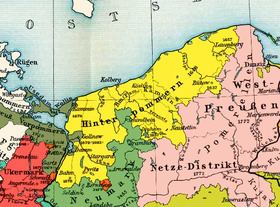 | ||
Farther pomerania top 6 facts
Farther Pomerania, Further Pomerania, Transpomerania or Eastern Pomerania (German: Hinterpommern, Ostpommern), is the part of Pomerania which comprised the eastern part of the Duchy and later Province of Pomerania. It stretched roughly from the Oder River in the West to Pomerelia in the East. Since 1945 Farther Pomerania has been part of Poland; the bulk of former Farther Pomerania is within the West Pomeranian Voivodeship, while its easternmost parts are within the Pomeranian Voivodeship. The Polish term Pomorze Zachodnie ("Western Pomerania"), in modern Polish usage, is a synonym to the West Pomeranian Voivodship; in Polish historical usage it applied to all areas west of Pomerelia (i.e. whole narrow Pomerania).
Contents
- Farther pomerania top 6 facts
- Terminology
- Towns
- Historical languages and dialects
- History Timeline
- References
Farther Pomerania emerged as a subdivision of the Duchy of Pomerania in the partition of 1532, then known as Pomerania-Stettin and already including the historical regions Principality of Cammin, County of Naugard, Land of Słupsk-Sławno, and the Lauenburg and Bütow Land. After the Brandenburg-Swedish partition of Pomerania, Farther Pomerania became the Brandenburg-Prussian Province of Pomerania (1653-1815). After the reorganization of the Prussian Province of Pomerania in 1815, Farther Pomerania was administered as Regierungsbezirk Köslin (Koszalin). In 1938, Grenzmark Posen-West Prussia was merged in. In 1945, Farther Pomerania was placed first under Soviet, subsequently under Polish administration, resettled primarily with Poles after the former German population fled or was expelled. Before 1999, the Szczecin Voivodeship (1945–1998) and its spin-offs Koszalin Voivodeship (1950–1998) and Słupsk Voivodeship (1975–1998) roughly resembled the area of former Farther Pomerania. The Szczecin and Koszalin Voivodeships were merged in 1999 and now constitute the West Pomeranian Voivodeship, while Słupsk Voivodeship was merged into the Pomeranian Voivodeship.
Terminology
The German prefix Hinter- denotes a location more distant from the speaker, and is the equivalent of "Farther" in English and Ulterior/Trans- in Latin (with the corresponding antonyms in German, English and Latin being Hinter-, "Hither" and Citerior/Cis-, respectively).
The toponym Pomerania comes from Slavic po more, which means Land at the Sea. Initially, Farther Pomerania referred to the areas beyond (i.e. lying east of) Pomerania-Wolgast, and the name eventually became adopted for areas east of Stettin by the 16th century. When the 1648 Peace of Westphalia and the Treaty of Stettin (1653) divided the Duchy of Pomerania into its Western, Swedish and Eastern Brandenburgian parts, Farther Pomerania was used for the latter - in opposition to Swedish Hither Pomerania (Vorpommern) now including Stettin (Szczecin) and a strip of land east of the Oder River. As this Swedish-Prussian border shifted west several times afterwards, the Oder River was considered the western edge of Farther Pomerania. To the Southeast and East, Farther Pomerania has no distinct border to the Pomerelian region, as the administrative borders between the duchy and later province of Pomerania and its neighbors varied significant over time. In the post-1945 era, Farther Pomerania was affected by the Polish-German border shift. Before, it happened to be the Eastern part of German Pomerania (Pommern, consisting of Hither and Farther Pomerania), yet thereafter it became the Western part of Polish Pomerania (Pomorze, consisting of Farther Pomerania and Pomerelia). As Polish Pomorze has also been in use for Pomerelia, Farther Pomerania is termed Western Pomerania in Poland and roughly represented in today's West Pomeranian Voivodeship, including Szczecin (Stettin) and Wolin (Wollin). However, this term is not being adopted by the Germans, as the German part of Pomerania (Hither Pomerania) is considered to be Western Pomerania, so Farther Pomerania is still in use.
Towns
Major towns of Farther Pomerania include:
